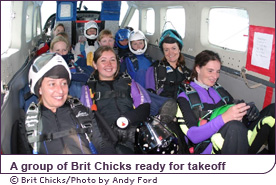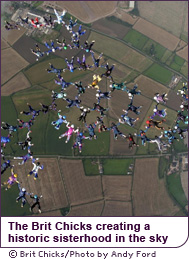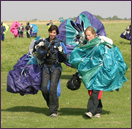

In Great Britain, it’s raining women.
For most of us, just jumping out of an airplane would be a feat in and of itself. But doing it while connected via wrists and ankles with 59 other women and plummeting toward earth at over 120 miles per hour is nothing less than extraordinary.
The Brit Chicks did just that on September 4, 2004, above Langar Airfield in Nottinghamshire, England, breaking their own national women’s formation-skydiving record for a 50-way jump in 2002.

The British formation record of 100 people was set in 2001, and the scarcity of women on the team was obvious to Lesley Gale and a few other grounded gals. The standing all-girl formation record was 38, so Gale formed the Brit Chicks to break that record, have fun, learn some new skills and raise the profile of women in the sport. In 2002, they broke the standing record with a 40-way and then immediately went on to break their own record with a 50-way later that week. Just two years later, the Chicks would outdo themselves yet again.
Jump Start
To prepare for another record-breaking jump, Gale, Kate Stephens and several other top British female skydivers pooled their resources to bring together planes, pilots, sponsors and, most importantly, jumpers. Finding 60 British female skydivers in a male-dominated sport wasn’t a breeze. The Brit Chicks came from all over England and represented every level of skydiving experience.
In skydiving, expertise is measured in jumps. The more jumps a diver has logged, the better. The Brit Chicks brought together top female jumpers (who had made 1,000-plus jumps each) and people who had made as few as 150 jumps in pursuit of the 60-way record. “We liked the idea of bringing up the new talent,” recalls Gale. “We really tried to split the experience up.”
Once the team was assembled, the Brit Chicks began extensive training. They started with their feet on the ground, talking about the jump, planning their strategy and doing dry runs on land (known as “dirt dives”), often balanced on big rubber balls. Each woman was given her “slot” (the position she would hold in the formation) and docking point (where she would attach herself to the formation). Then, still on the ground, they practiced “tracking off,” or moving away from each other laterally in order to open their parachutes’ canopies in clear air. After that stage, they broke down into four groups, each practicing its piece of the puzzle in real jumps. Finally, the day came to put it all together.
Falling for It
Once they had gotten their team, their planes and their plan together, the Brit Chicks had to wait for blue skies. For British skydivers, waiting for good weather is part of the challenge of skydiving. Vicki Priest doesn’t mind it a bit. “Even if the weather’s not good enough to jump, I’m hanging around the Drop Zone talking about jumping,” she shares. “It’s a lot like a club—I can drop in anytime I like just for a chat.”
The Langar Drop Zone has a bar that opens after the last plane is in, and skydivers are party people. Priest, an archaeologist at the University of Leicester, likes skydiving’s camaraderie: “Skydivers are people of widely different ages, backgrounds and careers and are, for the most part, totally ordinary people who just happen to jump out of planes on a weekend.”
 Brit Chick Lisa James recalls her flight up on one attempt to break the record: “[The ride up] begins with some small talk, but then it goes quiet as everyone’s thoughts turn to the task at hand. As we reach altitude, people suddenly come to life again, as pin checks are done, goggles are cleaned and helmets are put on again. Then we all scramble to the middle of the plane as we all hold hands and listen to Kate’s pep talk. The seats are moved back. The lights go on. The door is opened. Everything goes silent. Absolute silence. All you are concentrating on is the rig in front of you, waiting for the smallest movement.”
Brit Chick Lisa James recalls her flight up on one attempt to break the record: “[The ride up] begins with some small talk, but then it goes quiet as everyone’s thoughts turn to the task at hand. As we reach altitude, people suddenly come to life again, as pin checks are done, goggles are cleaned and helmets are put on again. Then we all scramble to the middle of the plane as we all hold hands and listen to Kate’s pep talk. The seats are moved back. The lights go on. The door is opened. Everything goes silent. Absolute silence. All you are concentrating on is the rig in front of you, waiting for the smallest movement.”
The first group out of a plane on a formation jump is the base group (usually the most experienced divers), which builds the center. They jump out of the plane together, holding hands. Next are the floaters, who hang onto the outside of the plane. There are front, rear and door floaters, depending on where they are positioned. The person in the door usually signals the exit on a “ready, set, go” count with a nod of the head or a shake of the leg. These three groups approach from different sides and latch onto the base group.
Once they are out of the plane, the Brit Chicks have only 50 seconds to get into their formation. “There are lots of safety issues to consider, jumping with that many other people,” says Priest, “such as in-air collisions, tracking, canopies, etc. And, of course, there’s the fear of doing something wrong and messing it all up for the other 59 girls.”
Gale adds that successful formation diving is “more about your headspace” than it is about physical prowess. “Everyone has to make the right decision in the same 50 seconds,” she notes. “If you go out thinking you’re going to mess it up, you probably will.”
Breasts Over Britain
In all, it took more than four hundred jumps to build up to the 50-way. It took five full-group attempts before the Brit Chicks finally pulled off their first record-breaking jump in 2002. James describes the experience: “We all explode out of the plane. The base is there, everyone is in her quadrant, grips are taken, and, as I look across the formation, I panic as I see somebody low—then realize it’s a cameraman. 
“Fifty faces look around, and we begin screaming and cheering as we realize that we’ve done it! We’ve set a new British women’s record—a 50-way! I’m still cheering as I turn and track. Only when the canopies open do I hear 49 other women whooping and cheering as well.”
For these gutsy women, there are many rewards for bravery. There is the satisfaction of knowing that they have been the first to do something, and there is pride in knowing that they have challenged themselves to new heights both literally and figuratively in a dangerous sport.
“It’s the most happy I’ve ever felt,” Gale says about reaching the 60-way mark in 2004, “to set sights on a goal and achieve it.”
Fellow Brit Chick Caroline Hughes shares, “It’s an ongoing challenge that focuses the mind. When you are skydiving you really know you’re alive.”
One Brit Chick posted the following testimonial on the dropzone.com forum:
Blue sky, and we just got a completed 60-way. 120 breasts over Langar and 4 of them were mine and Charlie’s!
For Lisa James, the satisfaction is in remembering those glorious seconds when they were all connected in mid-air: “We were each a part of that perfect moment in freefall.” So perfect, it was one for the record books.
:: Erika Schickel






